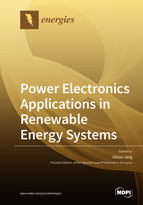Power Electronics Applications in Renewable Energy Systems
A special issue of Energies (ISSN 1996-1073). This special issue belongs to the section "F: Electrical Engineering".
Deadline for manuscript submissions: closed (20 December 2019) | Viewed by 46436
Special Issue Editor
Interests: HVDC control; transient stability; HVDC system planning
Special Issues, Collections and Topics in MDPI journals
Special Issue Information
Dear Colleagues,
The renewable generation system is currently experiencing rapid growth in various power grids. The stability and dynamic response issues of power grids are receiving attention due to the increase of power-electronics-based renewable energy. The main focus of this Special Issue is to provide solutions for power system planning and operation. Power-electronics-based devices can offer new ancillary services to several industrial sectors. In order to fully include the capability of power conversion systems in the network integration of renewable generators, several studies should be carried out, including detailed studies of switching circuits, and comprehensive operating strategies for numerous devices consisting of large-scale renewable generation clusters. The Special Issue of Energies, “Power electronics applications in renewable energy systems”, is intended to publish novel promising methods and techniques to maintain the stable operation of power grids with power electronic-based renewable resources.
Prospective authors are invited to submit original contributions for publication in this Special Issue. Topics of interest include, but are not limited to:
- Modeling of large scale PV and wind farms;
- Control design of renewable energy resources in grid operation;
- Application of power electronics-based storage devices for renewable energy resources;
- Grid inertia responses with renewable energy;
- Grid planning with large-scale renewable energy resources;
- HVDC applications for renewable energy resource integration;
- Voltage and frequency control of grids with a high penetration of renewable generation systems.
Prof. Dr. Gilsoo Jang
Guest Editor
Manuscript Submission Information
Manuscripts should be submitted online at www.mdpi.com by registering and logging in to this website. Once you are registered, click here to go to the submission form. Manuscripts can be submitted until the deadline. All submissions that pass pre-check are peer-reviewed. Accepted papers will be published continuously in the journal (as soon as accepted) and will be listed together on the special issue website. Research articles, review articles as well as short communications are invited. For planned papers, a title and short abstract (about 100 words) can be sent to the Editorial Office for announcement on this website.
Submitted manuscripts should not have been published previously, nor be under consideration for publication elsewhere (except conference proceedings papers). All manuscripts are thoroughly refereed through a single-blind peer-review process. A guide for authors and other relevant information for submission of manuscripts is available on the Instructions for Authors page. Energies is an international peer-reviewed open access semimonthly journal published by MDPI.
Please visit the Instructions for Authors page before submitting a manuscript. The Article Processing Charge (APC) for publication in this open access journal is 2600 CHF (Swiss Francs). Submitted papers should be well formatted and use good English. Authors may use MDPI's English editing service prior to publication or during author revisions.
Keywords
- renewable energy resources
- power electronics applications
- power grid planning and operation with large scale renewable energy resources
- energy storage systems for renewable energy resources






